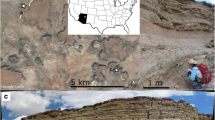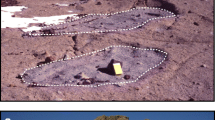Abstract
The volume, grain size, and depositional facies of material deposited outside an explosion crater, ejecta, are sensitive to the depth of the explosion, the explosion energy, and the presence or absence of a crater before the explosion. We detonate buried chemical explosives as an analog for discrete volcanic explosions in experiments to identify unique characteristics of proximal, medial, and distal ejecta facies and their distribution from a range of scaled depths in undisturbed and cratered ground. Ejecta are here discussed in terms of three facies: (1) proximal ejecta, which form a constructional landform around a crater; (2) medial ejecta, which form a continuous sheet deposit that thins much more gradually with distance; and (3) distal ejecta that are deposited as isolated clasts. The extent of proximal ejecta away from the crater, relative to crater size, is not sensitive to scaled depth, but the volume proportion of proximal ejecta to the total ejecta deposit is sensitive to the presence of a crater and scaled depth. Medial ejecta distribution and volume contributions are both sensitive to the presence of a crater and to scaled depth. Distal ejecta distance is dependent on scaled depth and the presence of a crater, while the volume proportion of distal ejecta is less sensitive to scaled depth or presence of a crater. Experimental facies and deposit structures inferred from observations of jet dynamics are used to suggest facies associations anticipated from eruptions dominated by explosions of different scaled depth configurations. We emphasize that significant differences in tephra ring deposits can result from the effects of scaled depth and preexisting craters on ejecta dynamics, and are not necessarily related to fundamental differences in explosion mechanisms or degree of magma fragmentation.







Similar content being viewed by others

References
Andrews RG, White JDL, Dürig T, Zimanowski B (2014) Discrete blasts in granular material yield two-stage process of cavitation and granular fountaining. Geophys Res Lett 41:422–428
Breard ECP, Lube G, Cronin SJ, Fitzgerald R, Kennedy B, Scheu B, Montanaaro C, White JDL, Tost M, Procter JN, Moebis A (2014) Using the spatial distribution and lithology of ballistic blocks to interpret the eruption sequence and dynamics: August 6, 2012 Upper Te Marri eruption, New Zealand. J Volcanol Geotherm Res 286:373–386
Browne PRL, Lawless JV (2001) Characteristics of hydrothermal eruptions, with examples from New Zealand and elsewhere. Earth-Sci Rev 52:299–331 doi:10.1016/S0012-8252(00)00030-1
Carey RJ, Manga M, Degruyter W, Swanson D, Houghton BF, Orr TR, Patrick MR (2012) Externally triggered renewed bubble nucleation in basaltic magma: the 12 October 2008 eruption at Halema’uma’u Overlook vent, Kilauea, Hawaíi, USA. J Geophys Res 117
Carrasco-Núñez G, Ort MH, Romero C (2007) Evolution and hydrological conditions of a maar volcano (Atexcac crater, Eastern Mexico). J Volcanol Geotherm Res 159:179–197
Gaffney ES (1981) Slumping and ejecta sliding accompanying some 10-ton cratering events. Geophys Res Lett 8(12):1207–1210
Goto A, Taniguchi H, Yoshida M, Ohba T, Oshima H (2001) Effects of explosion energy and depth to the formation of blast wave and crater: Field explosion experiment for the understanding of volcanic explosion. Geophys Res Lett 28:4287–4290 doi:10.1029/ 2001GL013213
Graettinger AH, Valentine GA, Sonder I, Ross P-S, White JDL, Taddeucci J (2014) Maar-diatreme geometry and deposits: subsurface blast experiments with variable explosion depth. Geochem Geophys Geosyst 15:740–764
Gurioli L, Harris AJL, Colo L, Bernard J, Favalli M, Ripepe M, Andronico D (2013) Classification, landing distribution and associated flight parameters for a bomb field emplaced during a single major explosion at Stromboli, Italy. Geology 41:559–562
Harris AJL, Ripepe M, Hughes EA (2012) Detailed analysis of particle launch velocities, size distributions and gas densities during normal explosions at Stromboli. J Volcanol Geotherm Res 231–232:109–131
Houghton BF, Swanson DA, Rausch J, Carey RJ, Fagents SA, Orr TR (2013). Pushing the Volcanic Explosivity Index to its limit and beyond: Constraints from exceptionally weak explosive eruptions at Kīlauea in 2008. Geology 41(6):627–630
Houghton BF, Swanson D, Carey RJ, Rausch J, Sutton AJ (2011) Pigeonholing pyroclasts: insights from the 19 March 2008 explosive eruption of Kilauea volcano. Geology 39:263–266
Housen KR, Schmidt RM, Holsapple KA (1983) Crater ejecta scaling laws: fundamental forms based on dimensional analysis. J Geophys Res Solid Earth 88:2485–2490
Jordan SC, Cas RAF, Hayman PC (2013) The origin of a large (>3 km) maar volcano by coalescence of multiple shallow craters: Lake Purrumbete maar, southeastern Australia. J Volcanol Geotherm Res 254:5–22
Kilgour G, Manville V, Della Pasqua F, Graettinger A, Hodgson KA, Jolly GE (2010) The 25 September 2007 eruption of Mount Ruapehu, New Zealand: directed ballistics, surtseyan jets, and ice-slurry lahars. J Volcanol Geotherm Res 191:1–14
Lorenz V (1986) On the growth of maars and diatremes and its relevance to the formation of tuff rings. Bull Volcanol 48:265–274
Lube G, Breard ECP, Cronin SJ, Procter JN, Brenna M, Moebis A, Pardo N, Stewart RB, Jolly A, Fournier N (2014) Dynamics of surges generated by hydrothermal blasts during the 6 August 2012 Te Maari eruption, Mt. Tongariro, New Zealand. Journal of Volcanology and Geothermal Research 286:348–366
Mattox T, Mangan M (1997) Littoral hydrovolcanic explosions: a case study of lava-seawater interaction at Kilauea volcano. J Volcanol Geotherm Res 75:1–17
Melosh HJ (1989) Impact cratering. A geologic process. Clarendon, Oxford
Moore JG (1985) Structure and eruptive mechanisms at Surtsey Volcano, Iceland. Geol Mag 122:649–661
Ohba T, Taniguchi H, Oshima H, Yoshida M, Goto A (2002) Effect of explosion energy and depth on the nature of explosion cloud. A field experimental study. J Volcanol Geotherm Res 115:33–42
Ort MH, Carrasco-Núñez G (2009) Lateral vent migration during phreatomagmatic and magmatic eruptions at Tecuitlapa Maar, east-central Mexico. J Volcanol Geotherm Res 181:67–77
Ripepe M, Rossi M, Saccorotti G (1993) Image processing of explosive activity at Stromboli. J Volcanol Geotherm Res 54:335–351
Ross P-S, White JDL, Zimanowski B, Büttner R (2008a) Multiphase flow above explosion sites in debris-filled volcanic vents: insights from analogue experiments. J Volcanol Geotherm Res 178:104–112
Ross P-S, White JDL, Zimanowski B, Büttner R (2008b) Rapid injection of particles and gas into non-fluidized granular material, and some volcanological implications. Bull Volcanol 70:1151–1168
Ross P-S, White JDL, Valentine GA, Taddeucci J, Sonder I, Andrews R (2013) Experimental birth of a maar-diatreme volcano. J Volcanol Geotherm Res 260:1–12
Rottas KM, Houghton BF (2012) Structure stratigraphy and eruption dynamics of a young tuff ring: Hanauma Bay, O’ahu, Hawaíi. Bull Volcanol 74:1683–1697
Self S, Kienle J, Huot J-P (1980) Ukinrek Maars, Alaska, II. Deposits and formations of the 1977 craters. J Volcanol Geotherm Res 7:39–65
Swanson DK, Wooten, T Orr (2009), Buckets of Ash Track Tephra Flux From Halema’uma’u Crater, Hawai’i, Eos Trans. AGU 90(46):427 doi:10.1029/2009EO460003
Taddeucci J, Scarlato P, Capponi A, Del Bello E, Cimarelli C, Palladino DM, Kueppers U (2012) High-speed imaging of Strombolian explosions: The ejection velocity of pyroclasts. Geophys Res Lett 39 doi:10.1029/2011GL050404
Taddeucci J, Valentine GA, Sonder I, White JDL, Ross P-S, Scarlato P (2013) The effect of pre-existing crater on the initial development of explosive volcanic eruptions: an experimental investigation. Geophys Res Lett 40:507–510
Valentine GA, White JD, Ross PS, Amin J, Taddeucci J, Sonder I, Johnson PJ (2012) Experimental craters formed by single and multiple buried explosions and implications for volcanic craters with emphasis on maars.Geophysical Research Letters, 39(20) doi:10.1029/2012GL053716
Valentine GA, Graettinger AH, Sonder I (2014) Explosion depths for phreatomagmatic eruptions. Geochemistry, Geophysics, Geosystems 41 doi: 10.1002/2014GL060096
Valentine GA, Graettinger AH, Marcops, Ross PS, White JD, Sonder I, Dohring E (2015) Experiments with vertically- and laterally-migrating explosions with applications to the geology of phreatic and phreatomagmatic eruptive centers and diatremes. Bull Volcanol. doi:10.1007/s00445-015-0901-7
White JDL, Ross P-S (2011) Maar-diatreme volcanoes: A review, J. Volcanol Geotherm Res 201:1–29 doi:10.1016/j.jvolgeores. 2011.01.010
Acknowledgments
This work was funded by the University at Buffalo 3E fund and the National Science Foundation (EAR 1420455 to GAV). JDLW’s participation was funded by the NZ Ministry of Business, Innovation and Employment via subcontract to GNS Science. Additional contributions from J. Taddeucci, D. Bowman, J. Lees, and E. Macorps are gratefully acknowledged. Practical assistance was kindly provided by B. Catalano, P. Johnson, D. Klingensmith, J. Krippner, T. Macomber, S. Morealli, P. Moretti, E. Panza, D.S.C. Ruth, R. Wagner, M. Williams, and J. Wilczak. We thank Gerardo Carrasco-Nuñez and Michael Ort for their helpful reviews of the manuscript.
Author information
Authors and Affiliations
Corresponding author
Additional information
Editorial responsibility: G. Giordano, acting Executive Editor
Electronic supplementary material
Below is the link to the electronic supplementary material.
Online Resource 1
(video): Video of experiment 2013aP2B2 showing typical ballistic curtain transport (i.e., Fig. 1a). This explosion occurred at a less than optimal scaled depth (0.0028 m/J1/3) through a preexisting crater where the scaled depth remained constant relative to the previous explosion (i.e., Fig. 5). The curtain expands away from the explosion source progressively depositing material at its base radially away from the explosion source. In these experiments, the curtain produces poorly sorted proximal ejecta, a medial ejecta blanket, and isolated distal clasts. The initial dark material in the jet is composed predominantly of gases from the explosion and assumed to contain minimal fine particles (MP4 4472 kb)
Online Resource 2
(video): Video of experiment 2013bP4B2 showing a dilute density current produced by the expulsion of fine material laterally during jet collapse into a crater (i.e., Fig. 1b). This explosion occurred at greater than optimal scaled depth (0.006 m/J1/3) through an existing crater where the scaled depth increased relative to the previous explosion (i.e., Fig. 5). The density currents produced by these experiments did not produce measurable deposits, but natural volcanic explosions likely produce appreciable deposits (e.g., maar and hydrothermal explosion tephra rings) (MP4 2053 kb)
Online Resource 3
(Table): Summary table of experimental data used in this study including explosion, crater and ejecta characterizations. The experiments are labeled by year, session (if multiple experiments were conducted in the same year), and pad number (i.e., YYYYaP#). A pad is the location of multiple explosions within the artificial stratigraphy. Previously published results and experimental descriptions can be found in Graettinger et al. (2014) for 2013a and Valentine et al. (2015) for 2014. The 2013b results were previously unpublished and 2012 data did not allow for ejecta volume calculations. Primary explosions are highlighted in gray, all other explosions occurred within a preexisting crater (PDF 150 kb)
Rights and permissions
About this article
Cite this article
Graettinger, A.H., Valentine, G.A., Sonder, I. et al. Facies distribution of ejecta in analog tephra rings from experiments with single and multiple subsurface explosions. Bull Volcanol 77, 66 (2015). https://doi.org/10.1007/s00445-015-0951-x
Received:
Accepted:
Published:
DOI: https://doi.org/10.1007/s00445-015-0951-x



